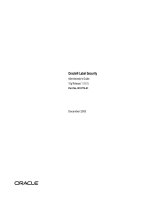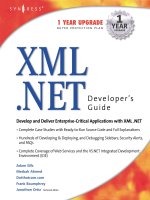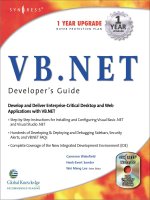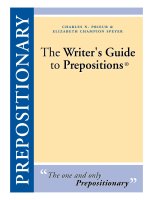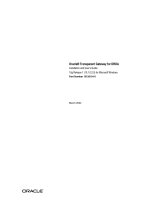SCIENTIFIC WRITING A READER AND WRITER’S GUIDE docx
Bạn đang xem bản rút gọn của tài liệu. Xem và tải ngay bản đầy đủ của tài liệu tại đây (1.41 MB, 223 trang )
SCIENTIFIC WRITING
A READER AND
WRITER’S GUIDE
January 19, 2007 wspc/spi-b452/FM Scientific Writing: A Reader and Writer’s Guide FA
This page intentionally left blankThis page intentionally left blank
JEAN-LUC
L EBRUN
Trainer
of
researchers and scientists from A*STAR Research Institutes. Singapore
Former Director, Apple-ISS Research Centre, Singapore
SCIENTIFIC WRITING
A READER AND
WRITER’S GUIDE
vp
World
Scientific
NEW JERSEY
-
LONDON SINGAPORE BElJlNG
-
SHANGHAI HONG
KONG
-
TAIPEI
-
CHENNAI
British Library Cataloguing-in-Publication Data
A catalogue record for this book is available from the British Library.
For photocopying of material in this volume, please pay a copying fee through the Copyright
Clearance Center, Inc., 222 Rosewood Drive, Danvers, MA 01923, USA. In this case permission to
photocopy is not required from the publisher.
ISBN-13 978-981-270-473-3
ISBN-10 981-270-473-6
ISBN-13 978-981-270-144-2 (pbk)
ISBN-10 981-270-144-3 (pbk)
Typeset by Stallion Press
Email:
All rights reserved. This book, or parts thereof, may not be reproduced in any form or by any means,
electronic or mechanical, including photocopying, recording or any information storage and retrieval
system now known or to be invented, without written permission from the Publisher.
Copyright © 2007 by World Scientific Publishing Co. Pte. Ltd.
Published by
World Scientific Publishing Co. Pte. Ltd.
5 Toh Tuck Link, Singapore 596224
USA office: 27 Warren Street, Suite 401-402, Hackensack, NJ 07601
UK office: 57 Shelton Street, Covent Garden, London WC2H 9HE
Printed in Singapore.
SCIENTIFIC WRITING: A READER AND WRITER’S GUIDE
Wanda - Scientific Writing.pmd 5/17/2007, 7:05 PM1
January 19,2007 wspc/spi-b452/FM Scientific Writing: A Reader and Writer’s Guide FA
Preface
You know how to w rite grammatically correct English. Congratula-
tions. You have read Strunk and White’s little book, The Elements of
Style.
a
Perfect. To pursue true writing excellence, you now need to
take into consideration the people key to your success: the readers.
What readers fear the most while reading a scientific paper is
to get stuck or left behind. They are stuck when the experienced
writer zigzags around the familiar obstacles in the knowledge field,
whilst readers crash into them; and they are left behind when the
knowledgeable writer runs where they can only walk. The knowl-
edge gap that separates you from your readers cannot be ig nored,
yet adequate background knowledge does not guarantee that moti-
vated readers will find reading your paper easy and rewarding. Much
more is required of them. A scientific paper requires more memory,
attention, and time than a typical novel of the same length. Good
writing should therefore take into account the reader’s ignorance,
fatigue, short-term memory, and impatience in order to minimise
their impact.
Unique writing techniques rarely presented in books on technical
writing will bring the writer closer to the six qualities that are the hall-
mark of great scientific writing: fluid, organised, clear, concise, con-
vincing, and interesting (FOCI). Consider sentence structure. Does
a
Strunk W Jr and White EB, The Elements of Style, Penguin Press, New York, 2005.
v
January 19,2007 wspc/spi-b452/FM Scientific Writing: A Reader and Writer’s Guide FA
vi Scientific Writing: A Reader and Writer’s Guide
placing a conjunction such as “because, “but,” or “although” at the
head of a sentence provide more reading pull than placing it midway?
Consider sentence progression. Does keeping the topic of the first
sentence constant throughout a paragraph help the reader progress
smoothly through a written argument? Consider the reader’s expec-
tations. Can a single word in a sentence trigger large expectations?
“Because it was raining that day,” creates the expectation that the
writer will explain what happened because of the rain. The sentence
finishes with “the paint did not dry on time.” The reader reaches the
end of the sentence knowing why the paint did not dry-the first expec-
tation raised is fulfilled, but another expectation arises: the paint
did not dry on time for what? Expectations drive reading forward
in science as they do in literature. By creating and controlling pull,
progression, and expectations, the writer can guide the reader.
Readers have different expectations for each part of a scientific
article, from its title to its conclusion. Since ignoring these expecta-
tions frustrates readers, the writer should avoid the short introduc-
tion that sheds little lig ht on the “what” and “why” of the paper, the
abstract that is indistinguishable from the conclusion, the misleading
title, the baggy structure, and the immature and unprocessed visuals.
This book will help writers lear n how to put together a coherent set
of parts that satisfies readers.
This book comes with a metaphorical box of chocolates: 48 stories
designed to liven up reading and reinforce the lear ning process. It also
comes with a core of 100 examples inspired or quoted from scientific
articles. No attempt has been made to “sweeten” them. Do not let
them intimidate you. What is of importance in each of these examples
is not their impact on the world of science: it is the placement of the
words in the sentence and the expectations the y create.
This book was written at the request of many scientists who
have participated in the scientific w riting skills seminars I conduct
January 19,2007 wspc/spi-b452/FM Scientific Writing: A Reader and Writer’s Guide FA
Preface vii
in various parts of the globe. In their assessment of the course, the
participants highlighted benefits; some expected, some unexpected.
As expected, those who had already published papers felt that their
writing had improved by keeping the reader in mind. Junior scientists
without any publishing experience were relieved that they no longer
had to blindly imitate the work of others, not knowing whether what
they were imitating was good or bad. Unexpectedly, even senior sci-
entists with great publishing experience found that the seminar had
improved their analytical reading skills and had equipped them with
amethodtoconductbetterpeerreviews.
Before turning the page,words of appreciation are due. More than
1000 scientists from many research centres helped me to understand
and love the scientific reader. This book is dedicated to them. Three
authors, through their books, influenced the contents of this book:
Michael Alley
b
on scientific writing, George Gopen
c
on reader energy
and expectations, and Don Norman
d
on user interfaces. They have
my deepest respect. They are the giants on whose shoulders I climbed
to discover a new world they had explored well before I did. If, thanks
to them, I discovered new techniques that will be of help to the reader
of this book, may they share the credit.
b
Alley M, The Craft of Scientific Writing, Springer, New York , 1997.
c
Gopen GD, Expectations: Teaching Writing from the Reader’s Perspective, Pearson Longman, 2004.
d
Norman D, The Design of Everyday Things, Basic Books, New York, 2002.
January 19, 2007 wspc/spi-b452/FM Scientific Writing: A Reader and Writer’s Guide FA
This page intentionally left blankThis page intentionally left blank
January 19,2007 wspc/spi-b452/FM Scientific Writing: A Reader and Writer’s Guide FA
Contents
Preface v
Part I The Reading Toolkit 1
Chapter 1 Require Less from Memory 3
• The Forgotten Acronym 3
• The Detached Pronoun 5
• The Diverting Synonym 10
• The Distant Background 11
• The Broken Couple 14
• The Word Overflow 16
Chapter 2 Sustain Attention to Ensure Continuous Reading 18
• Move Ideas Forward 19
• Make Important Things Stand Out 21
• Illustrate to Clarify 24
• Question to Engage 24
• Recreate Suspense 26
Chapter 3 Reduce Reading Time 29
• Visual Information Burgers 29
• Separating Space 30
• Trimmed and Discarded Text 31
ix
January 19,2007 wspc/spi-b452/FM Scientific Writing: A Reader and Writer’s Guide FA
x Scientific Writing: A Reader and Writer’s Guide
Chapter 4 Keep the Reader Motivated 35
• Dash or Fuel the Hopes of Your Readers: Your
Choice 36
• Meet the Goals of Your Readers to Motiv ate Them 39
Chapter 5 Bridge the Knowledge Gap 43
• ‘Ground Zero’ Bridges 45
• The Research Logbook: Keeping Track of the
Knowledge Gaps 48
Chapter 6 Set the Reader’s Expectations 52
• Expectations from Grammar, Syntax,
Punctuation, and Words 53
• Expectations from Science 56
Chapter 7 Set Progression Tracks for Fluid Reading 61
• Three Topic-Based Progression Schemes to
Make Reading Fluid 63
• Non–Topic-Based Progression Schemes 66
• Faulty Progression and Pause in Progression 71
Chapter 8 Create Reading Momentum 81
• The Text as Visual 83
• The Subclause Hook 83
• The Countdown 85
• The Story 86
• The Question 86
• The Example 86
Chapter 9 Control Reading Energy Consumption 88
• The Energy Bill 89
• The Role of Motivation 93
• Punctuation: a Refuelling Station 94
January 19,2007 wspc/spi-b452/FM Scientific Writing: A Reader and Writer’s Guide FA
Contents xi
Part II Paper Structure and Purpose 99
Chapter 10 Title: The Face of Your Paper 103
• Six Titles to Learn About Titles 104
• Six Techniques for Improving Titles 109
• Purpose and Qualities of Titles 114
• A Title to Test Your Skills 115
Chapter 11 Abstract: The Heart of Your Paper 118
• The Four Parts of an Abstract 120
• Coherence Between Abstract and Title 122
• The Tense of Verbs in an Abstract 126
• Purpose and Qualities of Abstracts 126
Chapter 12 Headings/Subheadings: The Skeleton of
Your Paper 129
• Three Principles for a Good Structure 130
• Syntactic Rules for Headings 137
• Purpose and Qualities of Str uctures 138
Chapter 13 Introduction: The Hands of Your Paper 141
• What Is Wrong with a Short Boilerplate
Introduction? 141
• The Introduction Answers Key Reader
Questions 143
• The Introduction Sets the Foundations of
Your Credibility 148
• The Introduction Is Active and Personal 151
• The Introduction Is Engaging and Motivating 154
Chapter 14 Introduction Part II: Popular Traps 159
• The Trap of the Story Plot 159
• The Trap of Plagiarism 165
• The Trap of Imprecision 169
January 19,2007 wspc/spi-b452/FM Scientific Writing: A Reader and Writer’s Guide FA
xii Scientific Writing: A Reader and Writer’s Guide
• The Trap of Judgmental Adjectives 170
• Purpose and Qualities of Introductions 172
Chapter 15 Visuals: The Voice of Your Paper 174
• Seven Principles for Good Visuals 176
• Purpose and Qualities of Visuals 196
Chapter 16 Conclusion: The Smile of Your Paper 198
• Purpose and Qualities of Conclusions 200
• Future Works 206
January 19,2007 wspc/spi-b452/FM Scientific Writing: A Reader and Writer’s Guide FA
Part I
The Reading Toolkit
This title probably conjures up the image of a schoolboy’s pen-
cilcase containing a few chosen articles designed to help reading: a
pair of glasses, a bookmark, instant coffee, etc. However, this toolkit
is quite special. It contains resources invisible to the naked eye, like
time, memory, energy, attention, and motivation. A skillful writer
minimises the time, memory, and energy needed for reading, while
keeping reader attention and motivation high.
1
January 19, 2007 wspc/spi-b452/FM Scientific Writing: A Reader and Writer’s Guide FA
This page intentionally left blankThis page intentionally left blank
January 24,2007 wspc/spi-b452/ch01 Scientific Writing: A Reader and Writer’s Guide FA
1
Require Less from Memory
The Forgotten Acronym
Letusstartwithastory.
A reading accident
Peter reads an article from the proceedings of a conference.
He follows the text in a linear fashion. Suddenly, he stops,
places his index finger underneath a word, and rapidly
scans the text he has just read, searching for something.
What he is looking for is not on the page. With his left hand,
he flips back one page, and then another he stops again.
His face lights up. Satisfied, Peter flips back to the page he
was reading before this unexpected and unwelcomed read-
ing U-turn, and sets his eyes back to where the index finger
marks the place for reading to resume. What happened?
A reading accident: the forgotten acronym. Peter probably
encountered an unfamiliar acronym defined only once by
the author at the beginning of the paper. Peter had read its
definition, but time had passed and he had forgotten it.
3
January 24,2007 wspc/spi-b452/ch01 Scientific Writing: A Reader and Writer’s Guide FA
4 Scientific Writing: A Reader and Writer’s Guide
Acronyms allow writing to be more concise. However, concise-
ness is unhelpful if it decreases clarity. An acronym is clear within the
paragraph in which it is defined. If it continues to be used regularly
in the paragraphs that follow, the reader is able to keep its mean-
ing in mind. But, if it appears irregularly or if reading is frequently
interrupted, the acronym — away from the warm nest of the reader’s
short-term memory — loses its meaning. Food gets cold fast when it
is out of the oven; you warm it up before eating it. Similarly, keep the
acronym warm in the reader’s memory; redefine it regularly in your
paper.
Reader curiosity or impatience also contributes to reading acci-
dents. The reader has the unfortunate habit (from the author’s
point of view) of skipping entire parts of your article to go directly
to a figure, or to a section in your paper that seems interesting
(via the heading or subheading). If the figure caption or the head-
ing/subheading contains acronyms, and if the reader has skipped the
sections that contain their definitions, then the accident will happen.
Avoiding problems with acronyms is easy:
•
If an acronym is used only two or three times in the entire paper,
it is better not to use one at all (unless it is as well known as IBM).
•
If an acronym is used more than two or three times, expand its
letters the first time it appears on a page so that the reader does
not need to flip pages back and forth. Some journals ask authors
to regroup all acronyms and their definitions at the beginning of
their paper so that the reader can locate them more easily.
•
Avoid acronyms in visuals or define them in their caption.
•
Avoid acronyms in headings and subheadings because readers
often read the structure of a paper before going inside the paper.
•
Be conservative. Define all acronyms, except those commonly
understood by the readers of the jour nal where your paper is
published.
January 24,2007 wspc/spi-b452/ch01 Scientific Writing: A Reader and Writer’s Guide FA
Require Less from Memory 5
The Singapore taxi driver
The other day, while I was in Singapore, I hailed a taxi. I
wanted to go to a research institute located on the cam-
pus of Nanyang Technology University (NTU). The taxi
stopped. I got in and said, “Nanyang Technology Univer-
sity, please.” The taxi driver, an old man who had clearly
been doing this job for many years, replied,“I do not know
where it is.” His answer surpr ised me. The university is old
and well established; surely he had taken passengers there
before. I started explaining that it was at the end of the
expressway towards Jurong all of a sudden, his face lit
up and he said with a large smile, “Ah! You mean NTU!”
That day, I learned that an acronym is sometimes better
known than its definition.
Notice the just-in-time definition of the acronym in the following
example.
The new universal learning algorithm SVM (support vector
machine) had a profound impact on the world of classification.
The Detached Pronoun
This, it, them, they, and their
a
are all pronouns.A pronoun usually
replaces a noun, but sometimes it replaces a phrase, a sentence, or
even a full paragraph. Like the acronym, it is a shortcut that avoids
the repetition o f words.
Pronouns and acronyms are both pointers. This characteristic is
at the root of all problems:
1. If you point in the direction of someone who has already left
the room, nobody will understand. Likewise, if the noun the
a
“Their” is not technically a pronoun: it is a possessive pronominal adjective, but it functions as a
pronoun. In the French language, “their” (leur) is a demonstrative pronoun.
January 24,2007 wspc/spi-b452/ch01 Scientific Writing: A Reader and Writer’s Guide FA
6 Scientific Writing: A Reader and Writer’s Guide
pronoun points to is 20 or 30 words back in the text, it may have
left the reader’s short-term memory; the noun–pronoun link is
broken. Usually, this memory lapse is not enough to discourage
readers from reading forward. They tolerate ambiguity and read
on because they are hopeful that the text will become clearer later.
Interpretation errors and reduced understanding are therefore
likely.
2. If you point towards a person in a group far away from you,
people will find it difficult to guess whom exactly you are pointing
to. When the pronoun points back to several likely candidates,
the reader — whose incomplete understanding of the text does
not allow disambiguation — will pick the most likely candidate
and read on, hoping clarity will be forthcoming. If that likely
candidate is the wrong one, then interpretation errors will follow
and understanding will drop to a lower le vel.
3. Finally, some fingers seem to point nowhere; actually, they point
somewhere, but only the person who is pointing knows where.
When the pronoun points to something that is only in the mind
of the author, the reader is left guessing and more often than not
guesses wrongly. Understanding thus drops to a lower level.
A diagram (☛1) helps to visualise the exploratory process fol-
lowed by readers when encountering a pronoun.
The new notation ☛1 is simply an invitation to look at visual 1.
I do not mention whether visual 1 is a diagram, a table, or a photo
because you know the difference.
Why the big black ☛ before the number? It is to help your eyes
easily return to the text at the right place after you have looked at
the visual. As you return, just let your eyes be guided by the dark
beacon.
The diagram highlights that a reader stops searching for another
candidate (i.e. antecedent) as soon as a likely one is found in his or her
January 24,2007 wspc/spi-b452/ch01 Scientific Writing: A Reader and Writer’s Guide FA
Require Less from Memory 7
Yes
Search all text located before the pronoun for a
meaningful candidate. Look first for a single
noun or nouns; if unsuccessful, consider part
of a sentence, a whole sentence, a group of
sentences, a paragraph, a group of paragraphs,
or the heading of the section where the
pronoun appears.
Correct
candidate?
Everything is
fine. Reader
reads on.
No
Yes
No
Confused
reader, hopeful
clarity will come
later, reads on.
Meaningful candidate in
reader's short-term memory?
No
Meaningful candidate in
text?
Misinformed
reader reads on.
One error may
generate more.
☛1. Process for finding a suitable candidate (antecedent) for a pronoun.
This diagram explores the process followed by readers looking for a candidate
(antecedent) for a pronoun. The writer should consider three important facts:
(1) Readers decide the meaningfulness of the match between a pronoun and its
candidate. Therefore, their knowledge of the topic is part of the process, and
little knowledge may mean greater ambiguity. (2) Readers stop looking for a
candidate as soon as they think they have found one (preferably in their short-
term memory). They do not have the energy, the time, or the will to stop and
analyse whether the pronoun candidate they chose is the correct one. As a result,
errors occur more frequently if the candidate is so distant from its pronoun
that it no longer is in memory. (3) Readers continue reading whether they
have identified the correct candidate or not. Being unable to find the candidate
may be less “damaging” to the understanding than continuing reading w ith a
“corrupted” understanding because, in the first case, the reader seeks to increase
understanding, while in the second case, the reader is lulled into a false sense of
understanding.
January 24,2007 wspc/spi-b452/ch01 Scientific Writing: A Reader and Writer’s Guide FA
8 Scientific Writing: A Reader and Writer’s Guide
short-term (working) memory. The choice of candidate is influenced
by the reader’s knowledge: the more superficial the knowledge, the
more error-prone the choice will be. Authors who wish nonexperts
to read their paper should be aware that pronouns present dangers.
In the following example, try and determine what the pronoun
“their” refers to. The three candidates are in bold. Had the sentence
been clear,this task would have been instantaneous. You will probably
struggle; but if you do not, ask yourself how much does knowledge
of the field assist you in making the correct choice.
The cellular automaton (CA) cell, a natural candidate to model
the electrical activit y of a cell, is an ideal component to use in
the simulation of intercellular communications, such as those
occurring between cardiac cells, and to model abnormal asyn-
chronous propagations, such as ectopic beats, initiated and
propagated cell-to-cell, regardless of the complexity of THEIR
patterns.
It is difficult to determine the plural noun pointed to by “their”
because the sentence segment “regardless of the complexity of their
patterns”could be moved around in the sentence and still make sense.
to use in the simulation of intercellular communications,
regardless of the complexity of their patter ns
to model abnormal asynchronous propagat ions, regardless
of the complexity of their patterns
such as ectopic beats, regardless of the complexit y of their
patterns
Communications, propagations, and beats can all display complex
patterns. Let us decide that in this text, “the ir” represents the “abnor-
mal asynchronous propagations.”
January 24,2007 wspc/spi-b452/ch01 Scientific Writing: A Reader and Writer’s Guide FA
Require Less from Memory 9
The ambiguity can be removed in different ways. First, one could
simply omit the detail if it is not essential, or make that point later
in the paragraph. The long sentence would then be seven words
shorter.
The cellular automaton (CA) cell, a natural candidate to model
the electrical activity of a cell, is an ideal component to use
in the simulation of intercellular communications, such as
those occurring between cardiac cells, and to model abnormal
asynchronous propagations, such as ectopic beats, initiated
and propagated cell-to-cell.
One could also rewrite the sentence to make the pronoun
disappear.
The cellular automaton (CA) cell — a natural candidate to
model the electrical activity of a cell — is an ideal compo-
nent to use in the simulation of intercellular communications,
such as those occurring between cardiac cells, and to model
the cell-to-cell initiat ion and propagation of abnormal asyn-
chronous events (such as ectopic beats) with or without complex
patterns.
Finally, one could repeat the noun instead of using a pronoun.
The cellular automaton (CA) cell, a natural candidate to model
the electrical activit y of a cell, is an ideal component to use in
the simulation of intercellular communications, such as those
occurring between cardiac cells, and to model abnormal asyn-
chronous e vents, such as ectopic beats, initiated and propa-
gated cell-to-cell, however complex the propagation pattern
may be.
In science, clarity overrides elegance; therefore, repeat to avoid
ambiguity.
January 24,2007 wspc/spi-b452/ch01 Scientific Writing: A Reader and Writer’s Guide FA
10 Scientific Writing: A Reader and Writer’s Guide
Search for the following words in your paper:
this, it, they, their, and them.
If you were the reader, could you easily identify
what the pronoun refers to without ambiguity?
If you could not, remove the pronoun and
repeat the noun(s)/phrase it replaces. An
alternate route consists in rewriting the whole
sentence in a way that removes the need for the
pronoun.
The Diverting Synonym
Bis repetitas placent
That day, I could not understand why the paragraph I was
reading was so obscure. The usual culprits were absent: the
grammar was correct and the sentence length was aver-
age for a scientific article. I had noticed that words were
repeated,but repetition usually clarifies and does not blight
understanding. I decided to try and remove some of the
repeated words. I then discovered the problem: four syn-
onymous expressions.
1. Known or predefined location.
2. Predefined location information.
3. Preprogrammed location information.
4. Identifiable position information.
The author could have continued the game and added a
few more synonymous expressions:
5. Identifiable location information.
6. Predefined position information.
7. Preprogrammed p osition information.
After removal of the synonyms, the structural problems
appeared clearly. The paragraph was thus easier to rewrite.
January 24,2007 wspc/spi-b452/ch01 Scientific Writing: A Reader and Writer’s Guide FA
Require Less from Memory 11
Your language teacher may have told you to avoid repeating nouns
within a sentence or in consecutive sentences. The advice given was,
“Use synonyms, demonstrate your knowledge of the vast English
vocabulary.” In science, however, synonyms confuse readers, partic-
ularly those not familiar with the specialised terms used in your field.
Therefore, avoid synonyms. Make your writing clear by consistently
using the same keywords, even if it means repeating them. As an
added benefit, you will lessen the demands on the memory of your
readers: fewer new words also means less to remember.
The Distant Background
The Macintosh factory
When I moved to Cupertino, California, in 1986 to work
at the headquarters of Apple Computer, I visited their
Macintosh factory in Fremont. Every day, truckloads of
components and parts came in, just enough for one day’s
production; and every day, containers of Macintoshes were
shipped out. The net result: no local storage, no warehous-
ing. I was witnessing a very efficient technique: just-in-
time (JIT) manufacturing .
Traditionally, the background material the reader needs to under-
stand your contribution is written in the first part of your article. If
this background material is not used immediately, the memory will
have to store it for later use. Unfortunately, the memory warehouse
is small and the warehouse keeper is quite busy.
The variable types
There are two types of variables in a computer programme:
global and local variables. Global variables are declared at
(Continued)
January 24,2007 wspc/spi-b452/ch01 Scientific Writing: A Reader and Writer’s Guide FA
12 Scientific Writing: A Reader and Writer’s Guide
(Continued)
the beginning of a programme and are known through-
out the programme. Local variables are known only within
the subroutine where they are declared. This interest-
ing concept allows the computer to manage its memory
space more efficiently. Global variables require permanent
storage, whereas local variables free up their temporary
memory storage space as soon as the progr amme exits
the subroutine. Could this wonderful concept apply to
writing?
Parking all background material in the introductory sections of
your paper increases the demands on the reader’s memory. Back-
ground material comes in two forms: the global background, appli-
cable to the whole paper; and the local or just-in-time background,
useful only to one section or paragraph of your paper. The just-in-
time background imposes no memory load: it immediately precedes
or follows what it makes clear. Here is a just-in-time example:
Additional information is readily available from “context” —
other words found in the vicinity of the word considered.
In this example, the word “context”isdefinedassoonasitappears.
When a heading or subheading in your paper contains a word
requiring an explanation, explain it in the first sentence under the
heading, in a just-in-time fashion.
Lysozyme solution preparation
Lysozyme, an enzyme contained in egg white,
In this subheading, the word“lysozyme”is unusual. The writer defines
it in the first sentence of the section.




